Lydd Military History
Lydd has had a long association with the military, going back to the 19th century.
Lydd was known as a military town even prior to the First World War, housing an established Army Training Camp. The Royal Garrison Artillery was a military barracks, and the School of Siege Artillery served as an important training facility. As well as this the Lydd Ranges are a part of the Cinque Ports Firing Ranges, which also contained a military hospital.
The Lydd Ranges had been used for trials of techniques and munitions, with the explosive Lyddite taking its name from the place where it was developed.
The First World War saw the expansion of Lydd as a military garrison, and the Camp was extended through the building of metal huts which were known to the locals as Tin Town. Men from Lydd served in all theatres of the War, and those who lived and trained at the Army Barracks were joined by a variety of combatants from Canadian riflemen and the Australian forces.
The picture at the top of the page is of Lydd Military camp in 1905
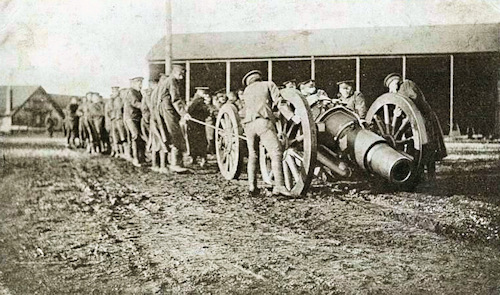
The Royal Garrison Artillery at Lydd
It is interesting to note that within the Army Camp itself there were over five miles of railway track. The railway link from Lydd to Ashford was operated by the South Eastern Railway, and traffic was greatly increased during the war as it was a direct route for supplies to the Camp and for other training facilities within the area. In 1916 the No 2 Royal Flying Corps Balloon School was established in partnership with the Siege Artillery Brigade. Balloons were used for artillery range spotting and the balloon sheds and camp were noticeable from the town due to the flat terrain.
Kites were also used. Kites came into army use for observation purposes. These were mounted on wagons drawn by horses, with a drum carrying the wire and a means for winding. Small lifting kites were sent up first, and then the soldier (usually an officer), would be lifted in a basket attached below the man lifting the kite.
For the locals, another visible aspect of the military within the town would have been patrols carried out by the Kent Cyclist Battalion, and in 1918 Lydd became a home base to the 2/1st Cyclist Battalion.
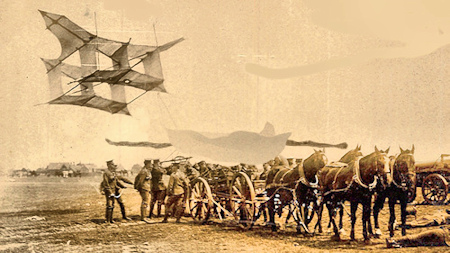
Kite Team Lydd c1909
Lydd Ranges have been used for military training since c1860 and is part of the Dungeness, Romney Marsh and Rye Bay Site of Special Scientific Interest.
Because the range is used for live firing, access is sometimes restricted - red flags are flown during these times, and access is prohibited along the foreshore and Galloways Road.
Also, red lights are shown at restricted times if there is poor weather.
The danger area extends out to sea, and mariners sailing to and from Rye Harbour must pass south of the Stephenson Shoal to avoid it.
Firing occurs about 300 days a year. When firing is not taking place, it may be possible to walk along a designated path along the shore.
Contact Information
For further information on live firing times contact:
![]() 01303 225518 (office hours) or
01303 225518 (office hours) or ![]() 01303 225467 (out of hours).
01303 225467 (out of hours).
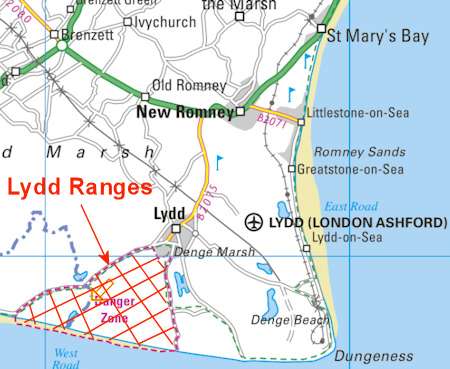
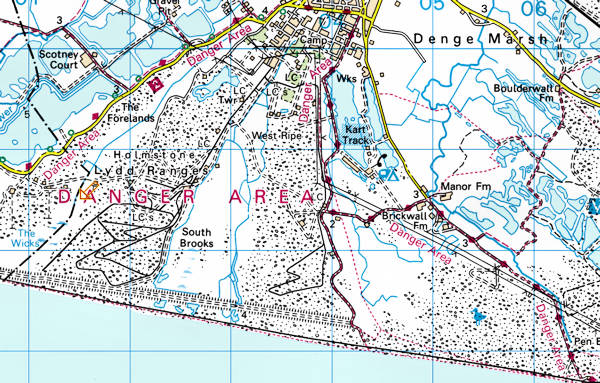
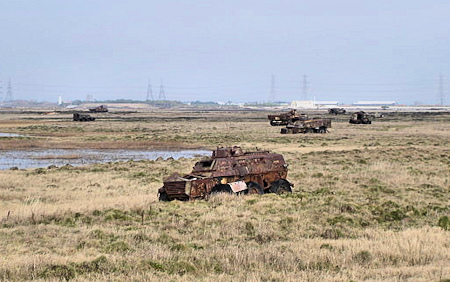
Lydd Ranges
The 2nd Line battalion was formed at Canterbury in 1914 or 1915;[ it remained in England throughout the war. In 1916 it was still at Canterbury. By September 1916, the battalion had joined the 6th Cyclist Brigade (former 15th Mounted Brigade) in the 2nd Cyclist Division. The brigade was headquartered at Wingham, Kent. The division was broken up on 16 November 1916 and the battalion was transferred to 5th Cyclist Brigade (former 9th Mounted Brigade) in the new 1st Mounted Division[ at Ramsgate. By May 1917, it was attached to 67th (2nd Home Counties) Division and was at Folkstone from May to August 1917.
In March 1918, the battalion returned to The Cyclist Division where it remained until the end of the war. It was at Lydd from August 1918 and in November 1918 was at Folkstone.The battalion was disbanded on 28 July 1919.
On 4 July 1915, the battalion provided personnel for the 9th Provisional Cyclist Company. The company was disbanded at Margate on 13 April 1916.
Lyddite was a form of high explosive widely used during both the Boer War and First World War, most notably during the latter by the British. It was named after the town of Lydd in which the substance's initial trials were performed so as to maintain secrecy, Lyddite was actually composed of molten and cast picric acid.
First tested in 1888 Lyddite was considered a relatively 'insensitive' explosive, which meant that it lent itself moderately well to armour piercing shells, given that the substance was less liable to detonate immediately upon impact but would instead be triggered by an impact fuse. In practice however, Lyddite shells would detonate while in the process of tearing through armour.



